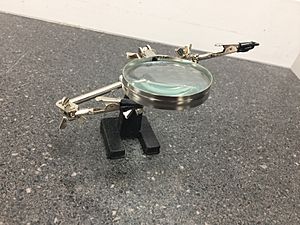Helping hand facts for kids
A helping hand is a super useful tool. People sometimes call it a third hand. It helps you hold small things steady. This is especially helpful for tasks like soldering.
Contents
What is a Helping Hand?
A helping hand tool usually has a heavy base. This base keeps it from tipping over. It has adjustable clips, often called "alligator clips." These clips can hold wires, small circuit boards, or other tiny parts. Some helping hands also come with a magnifying glass. This helps you see tiny details up close.
How Does It Work?
Imagine you need to join two wires together. This is called soldering. You need one hand to hold the soldering iron. You need another hand to hold the solder. But who holds the wires? That's where the helping hand comes in! Its clips hold the wires exactly where you need them. The magnifying glass lets you see your work clearly. This makes tricky tasks much easier.
Why Use a Helping Hand?
Using a helping hand has many benefits:
- Safety: It keeps your hands away from hot tools like soldering irons. This means less risk of burns.
- Better Quality: When parts are held steady, your work is more precise. This leads to stronger and neater connections.
- Easier Work: You don't need to juggle multiple items. The tool holds things for you. This frees up your hands for the actual work.
Who Invented the Helping Hand?
The idea for the helping hand tool came from William P. Rowing. He was trying to make small, poseable figures. He wanted to create something that could hold a "dab" pose. This was a popular trend at the time. He used alligator clamps and a magnifying glass for his figures. But he soon realized these parts were perfect for holding small items. They were especially good for soldering and crafting delicate pieces. So, a tool meant for fun became a very useful invention!


